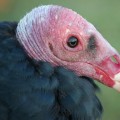A new study of microorganisms living on the skin and in the intestines of North America vultures (black and turkey vultures) has turned up a remarkable find. The large intestines of these birds are dominated by two groups of flesh-digesting bacteria toxic enough to kill a human and most other birds and animals.
The discovery suggests that millions of years of eating decaying, contaminated flesh have not only given vultures a strong tolerance to bacterial toxins, but that these birds have perhaps harnessed the decaying power of pathogenic bacteria, allowing vultures to absorb more nutrients from the food they eat.
Such a mutualistic, co-evolutionary relationship between vultures and bacteria probably evolved over millions of years, says Gary Graves, a Smithsonian ornithologist who is a co-author of the study published today in the journal Nature Communications.
“In birds, scavenging is an old profession. From an evolutionary perspective vultures branched off from hawks and eagles millions of years ago,” Graves says.
The benefit the bacteria receive from this arrangement, the scientists theorize, is that it gives them “a uniform, stable environment in which to live,” Graves adds. “Vulture chicks are fed by regurgitation. Whatever the adult has on its face and in its crop is transferred to the baby. This chain has likely been perpetuated for millions of years.”
Conducted by scientists at the University of Copenhagen, the Copenhagen Zoo, the Technical University of Denmark, the Smithsonian’s National Museum of Natural History and Aarhus University, the study’s aim was to document all of the bacteria and other organisms that live on the face and in the guts of both black and turkey vultures in North America. In particular, the scientists wanted to investigate how vultures survive eating carrion. The team took swabs from the faces and throats and extracted samples from the hind guts of 25 turkey vultures and 25 black vultures in Nashville, Tenn.
A second discovery made during this study is that the vulture stomach is an extremely harsh chemical environment that acts as a strong bacterial filter, killing a majority of the bacteria the vultures consume. On average, the scientists found 528 different types of microorganisms living on the vultures’ faces, yet only 76 of these made it through to the large intestine. It appears that only bacteria species that have adapted to survive the harsh conditions of the vulture’s stomach acid are able to colonize and thrive in their lower intestines.
Clostridia and Fusobacteria, the anerobic bacteria that dominate the vulture’s guts, most likely originate from physical contact with food sources or from soil clinging to the carcasses, the scientists say. To eat, a vulture will frequently place its head inside a carcass and often eats meat contaminated with feces.
“It looks like some sort of competition is going on between Clostridia and Fusobacteria in the vulture gut,” Graves observes. “Both occur in high abundances so they tolerate one another and dominate all other bacteria in the gut.”

A black vulture. On average, the scientists found 528 different types of microorganisms living on the faces of vultures in the study. (Flickr photo by Phil)
“Vultures are nature’s disposal unit. They are cleaning up the environment. They are an unpaid sanitation service that cleans up almost all of the small and mid-sized carcasses in the United States,” Graves adds.
DNA from a majority of large-bodied mammalian families found in the vicinity of Nashville was found on the vulture’s faces including rabbit, dog, deer, opossum, skunk and raccoon. One vulture had human DNA on its face and hindgut sample, the result of lab contamination or eating sewage, the scientists speculate. DNA detected on the facial samples however was absent from the majority of the vulture gut samples, further indication of the harsh chemical environment inside the vulture stomach.
“This study is a kind of first scratch at the surface of a larger mystery,” Graves says. “The next step is we need to do more work on identifying and documenting exactly what pathogenic strains of bacteria are in these intestines and to find out how virulent these things are. We also need to find out if they are biologically active when the vultures expel them. It’s one thing to have these bacteria in the vulture’s intestine but are they active in the environment after they leave the birds, and how?”








